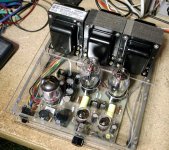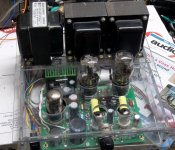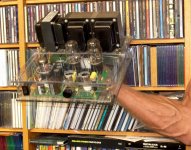That was my question, too, is the mVAC level the same on both channels. The OP said 6.3 mv, but was that on both channels evenly? Such an even level doesn't make much sense to me except maybe from B+ ripple.I would still expect the channel with the OPT closer to the power transformer to have more hum.
George, just how much ripple (60 or 120) would you normally expect to see in a typical build, say with and without a choke? As far as I know, no one has measured a normal build yet.
As a side question, I figure that those speakers, if they are 112 dB/2.82V/m, would produce about .25 dB SPL at 1 meter with that 6.3 mv level. Did I do that right? That almost doesn't sound audible, but I guess hum is pretty objectionable at any level. The threshold of normal hearing is supposed to be 0 dB SPL by definition. Of course, that .25 figure is at 1 meter, so right up close, it could be pretty bad sounding. More normal speakers, say, 92 dB sensitivity, would be 20 dB quieter, or about 1/4 perceivable loudness. Maybe that would make enough difference in this case. A bit of rambling, but does that make any sense?
That was my question, too, is the mVAC level the same on both channels. The OP said 6.3 mv, but was that on both channels evenly? Such an even level doesn't make much sense to me except maybe from B+ ripple.
George, just how much ripple (60 or 120) would you normally expect to see in a typical build, say with and without a choke? As far as I know, no one has measured a normal build yet.
As a side question, I figure that those speakers, if they are 112 dB/2.82V/m, would produce about .25 dB SPL at 1 meter with that 6.3 mv level. Did I do that right? That almost doesn't sound audible, but I guess hum is pretty objectionable at any level. The threshold of normal hearing is supposed to be 0 dB SPL by definition. Of course, that .25 figure is at 1 meter, so right up close, it could be pretty bad sounding. More normal speakers, say, 92 dB sensitivity, would be 20 dB quieter, or about 1/4 perceivable loudness. Maybe that would make enough difference in this case. A bit of rambling, but does that make any sense?
Thanks again guys.
Yes, both channels have the same amount of hum. I did scope it before and I am sure it is 60 Hz. I even built like a metal box, one face open, and placed on the power transformer as a shield, grounded to the chassis, to no avail.
I hope I can see a difference somehow in the figures I am measuring if I move the transformers further away or change its orientation. I replaced all the tubes, plug the amp to PC, direct to the wall, have the input shorted when ON, etc. Re-route all the wires coming from the transformer, re-orient choke, etc. No change.
I built amps before. I am lost in this one. I have a 2A3 amp that is AC heated and measures only around 1.98 ~ 2.2 mVac depending on the output tubes being use with input fully open.
I will solve this, in time.
thanks again,
Abe
George, just how much ripple (60 or 120) would you normally expect to see in a typical build,
I currently have a very non typical SSE running on my bench. There is no chassis, just the board, the transformers and a volume pot all laying on top of an old power supply, which does have a grounded metal case. There is a 6Hy Triad choke but no motor run cap. The hum and noise measures 2.2 mV in one channel and 2.8 mV in the other channel using the AC volts scale in my HP8903A audio analyzer. The frequency readout is usually blank since it can't always get a reading but 120 Hz flashes every once in a while. The scope reveals about equal amounts noise (hiss) and 120 Hz ripple. It is totally inaudible on my 87db Yamaha speakers, but my hearing is also quite bad lately.
I have a completed SSE on a chassis sitting on the shelf lonely and crying out for a fresh jolt of electricity. My old Industrial Strength Amp. It hasn't been plugged in in nearly a year, so I will try it and see what happens.
The postman brought me the CD's that I ordered from Amazon 3 WEEKS AGO so I got the old SSE off the shelf and plugged it in. I was half expecting some smoke, but no......it just worked. Even after sleeping for nearly a year it still rocks. I tried it with no input, with the CD player connected and the volume all the way down, and with the CD player paused and the volume at max. I get the same readings 1.6 mV on each channel. I decided that the $30 WalMart DVD player sounded.....well, like a $30 WalMart DVD player so I hooked up a 20 year old Technics MASH player. It rocks. Still 1.6 or 1.7 mV on either channel at full volume, player paused. The scope shows a near sine wave at 120 Hz on each channel.
This is probably the very first SSE that was ever completely built into a chassis. I had an older breadboarded amp, but I stole its Edcors for a TSE. This one uses Transcendar OPT's, a cheap Allied (Hammond) 6K7VG power trasnformer, a 100 uF 370 VAC Ebay sourced motor run cap, and a 1.5 Hy Triad choke because the 6 HY one wouldn't fit. It is an example of how not to build an amp since the chassis is too small, and the power transformer is severly overloaded (220 mA from a 150 mA transformer). It gets HOT, but has performed flawlessly for about 6 years since blowing its diodes on day 2. The second set of diodes are still good.
It is currently halfway through the second CD of a 2 CD Jesse Cook set at the edge of clipping. I had forgotten how good this old guy sounds.
SO, the answer is.....1.6 mV should be achievable, certainly 2mV.
This is probably the very first SSE that was ever completely built into a chassis. I had an older breadboarded amp, but I stole its Edcors for a TSE. This one uses Transcendar OPT's, a cheap Allied (Hammond) 6K7VG power trasnformer, a 100 uF 370 VAC Ebay sourced motor run cap, and a 1.5 Hy Triad choke because the 6 HY one wouldn't fit. It is an example of how not to build an amp since the chassis is too small, and the power transformer is severly overloaded (220 mA from a 150 mA transformer). It gets HOT, but has performed flawlessly for about 6 years since blowing its diodes on day 2. The second set of diodes are still good.
It is currently halfway through the second CD of a 2 CD Jesse Cook set at the edge of clipping. I had forgotten how good this old guy sounds.
SO, the answer is.....1.6 mV should be achievable, certainly 2mV.
I assume you're referring to the old SSE...I had forgotten how good this old guy sounds.
Thanks for taking the time to do this. It will help for future builds (like mine). I hate hum no matter the source. Even at very low levels, it is very annoying and sometimes hard to fix.
Case in point: The guitar amp I referred to earlier was a Peavey ValveKing 112. I happened to get a new one that had this hum pretty bad out of the box and Peavey never acknowledged it as a problem even though many people had it. It only occurred on some units, not all. There were many discussions about it on forums, and as many suggestions as there were forum posters it seemed, from pot grounding to trace cutting. The most successful solution was cutting the trace in the hi Z signal line and replacing the trace with a length of coax off the PCB. However, at least one guy reported measuring an abnormally high temperature on one of the filter caps. He was successful at replacing the cap (which, ironically, voided the warranty!) My guess is that some of the units left the factory with leaky caps which caused high ripple on the B+. The PCB trace picked it up, but an isolated coax line would not. I fixed my problem in a more direct way; I returned it and got a Fender!
This story only to illustrate that even new commercial units can have frustrating hum problems. Funny that Peavey never did acknowledge the problem as a warranty issue, but later on some guy sent a pic of a new one he had just bought in which the signal line was now a coax, off the board! Maybe it's an over-reaction, but I just can't trust Peavey now, which is too bad, because I really like that Tweed Delta Blues 115!
Sorry, didn't mean for the story to turn to a rant, but at least I feel all better now...
PROBLEM Solved!
Turn the transformer 90 deg. , measured 3.2 mV for 6L6GC. Re-dress the HV and rectifier(5V) line and cleaned the board with ISP, hum measured at 2.0 to 2.3mVac. depending on the tubes being use(Mullard EL 34 at 1.92 mVac!) That should be it.
For those who participated in this thread, hats off to you. Thanks guys!!
Abe
Turn the transformer 90 deg. , measured 3.2 mV for 6L6GC. Re-dress the HV and rectifier(5V) line and cleaned the board with ISP, hum measured at 2.0 to 2.3mVac. depending on the tubes being use(Mullard EL 34 at 1.92 mVac!) That should be it.
For those who participated in this thread, hats off to you. Thanks guys!!
Abe
Last edited:
Turn the transformer 90 deg.
That was my first thought. If you look at the early pictures of my Lexan Tubelab SE you will see the 3 transformers all lined up in a row. That worked well for me on my 87db Yamahas which are more like 70db at 60 Hz. When it went to visit some 95db Sonus Fabers it went HUMMMMMMMMM. This led to the rotation of the power transformer 90 degrees. All quiet on the hum front. When it went to visit some 106db Lowther based horns, I added a choke and an aux cap. Again all quiet.
I included 3 pictures. The first shows the Lexan TSE as it was originally built, maybe 7 or 8 years ago. The 3 transformers are all lined up in a row, and it still has the prototype home cooked PC board. That was long before I decided to start selling PC boards. The first change was to rotate the power transformer.
The next two pictures show the same amp as it exists today. The PC board has been swapped for a commercial quality board, and a choke and aux cap were added. The choke can be seen to the right of the right output tube, and the aux cap can be seen between the output tubes. The cap is a white leaded 20 uF ASC poly cap. I also used a much larger heat sink on the filament regulator chip so that I can run tubes bigger than the 45's shown. 300B's work well in this amp and they can play all day long but only provide about 5 watts per channel with the little power transformer. 2A3's work, but the power transformer gets too hot to touch after 1/2 hour. This amp is now a study in too much stuff in too small a package, but it does not hum on 106 db horns and has whipped up on some real expensive amps in listening sessions.
The original version got loaned out and demo'ed by several people who asked me to make them one. The hand made PC boards took the most time, so I went to a board shop and had 50 of them made. Then I couldn't make enough amps to satisfy the demand so I wrote some instructions such that felow tube heads could make their own, and then........
Attachments
That was my first thought. If you look at the early pictures of my Lexan Tubelab SE you will see the 3 transformers all lined up in a row. That worked well for me on my 87db Yamahas which are more like 70db at 60 Hz. When it went to visit some 95db Sonus Fabers it went HUMMMMMMMMM. This led to the rotation of the power transformer 90 degrees. All quiet on the hum front. When it went to visit some 106db Lowther based horns, I added a choke and an aux cap. Again all quiet.
I included 3 pictures. The first shows the Lexan TSE as it was originally built, maybe 7 or 8 years ago. The 3 transformers are all lined up in a row, and it still has the prototype home cooked PC board. That was long before I decided to start selling PC boards. The first change was to rotate the power transformer.
The next two pictures show the same amp as it exists today. The PC board has been swapped for a commercial quality board, and a choke and aux cap were added. The choke can be seen to the right of the right output tube, and the aux cap can be seen between the output tubes. The cap is a white leaded 20 uF ASC poly cap. I also used a much larger heat sink on the filament regulator chip so that I can run tubes bigger than the 45's shown. 300B's work well in this amp and they can play all day long but only provide about 5 watts per channel with the little power transformer. 2A3's work, but the power transformer gets too hot to touch after 1/2 hour. This amp is now a study in too much stuff in too small a package, but it does not hum on 106 db horns and has whipped up on some real expensive amps in listening sessions.
The original version got loaned out and demo'ed by several people who asked me to make them one. The hand made PC boards took the most time, so I went to a board shop and had 50 of them made. Then I couldn't make enough amps to satisfy the demand so I wrote some instructions such that felow tube heads could make their own, and then........
Thanks George!
Interesting to have the effect quantified. I've wondered what the actual difference would be. Pretty significant.
This also illustrates a potential problem with very high efficiency speakers that I haven't thought about before. They might make a high noise floor more audible, making it that much more important to have a good quality source and amp components.
This also illustrates a potential problem with very high efficiency speakers that I haven't thought about before. They might make a high noise floor more audible, making it that much more important to have a good quality source and amp components.
Last edited:
- Status
- This old topic is closed. If you want to reopen this topic, contact a moderator using the "Report Post" button.
- Home
- More Vendors...
- Tubelab
- Hum On SSingle Ended


